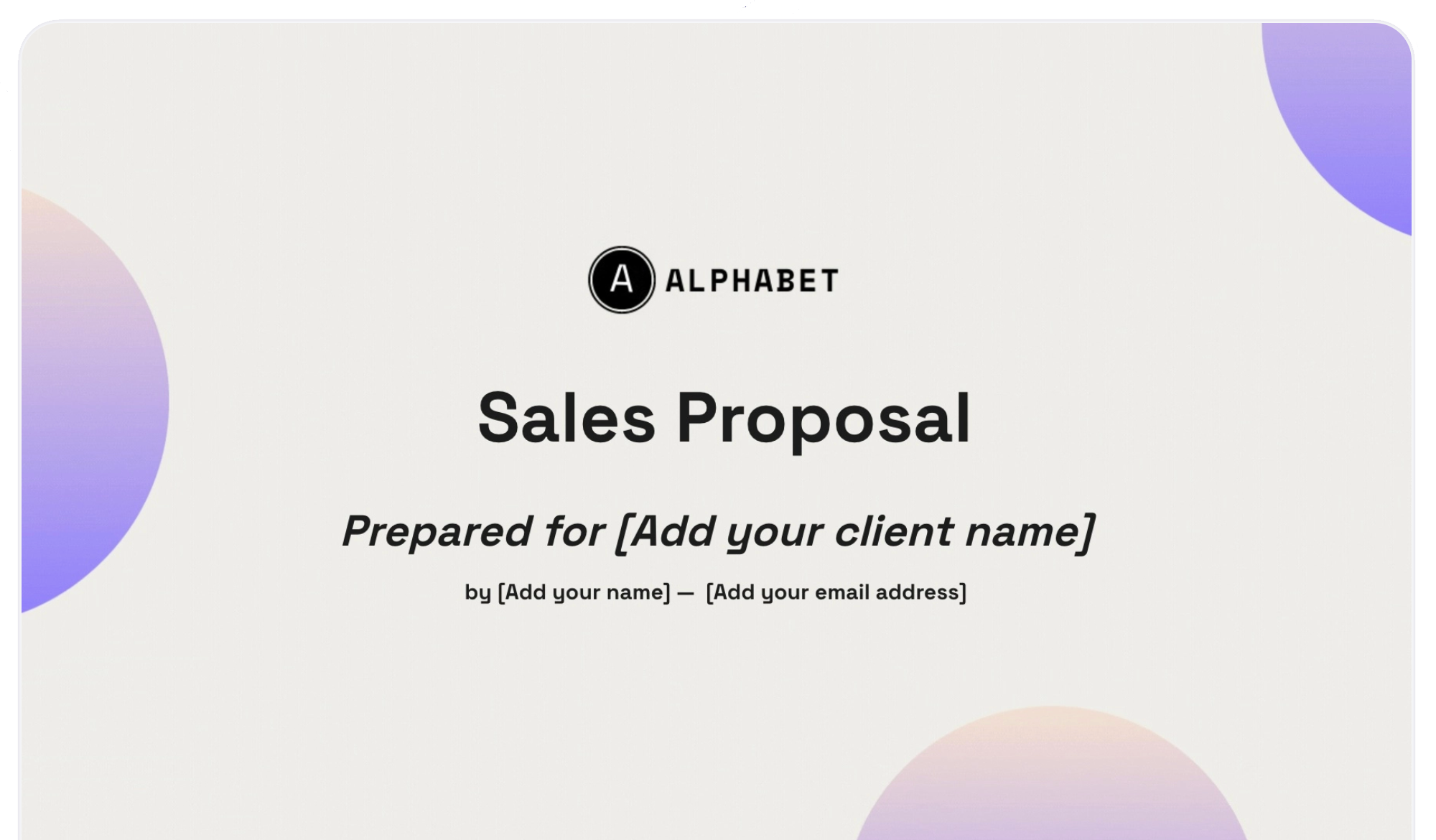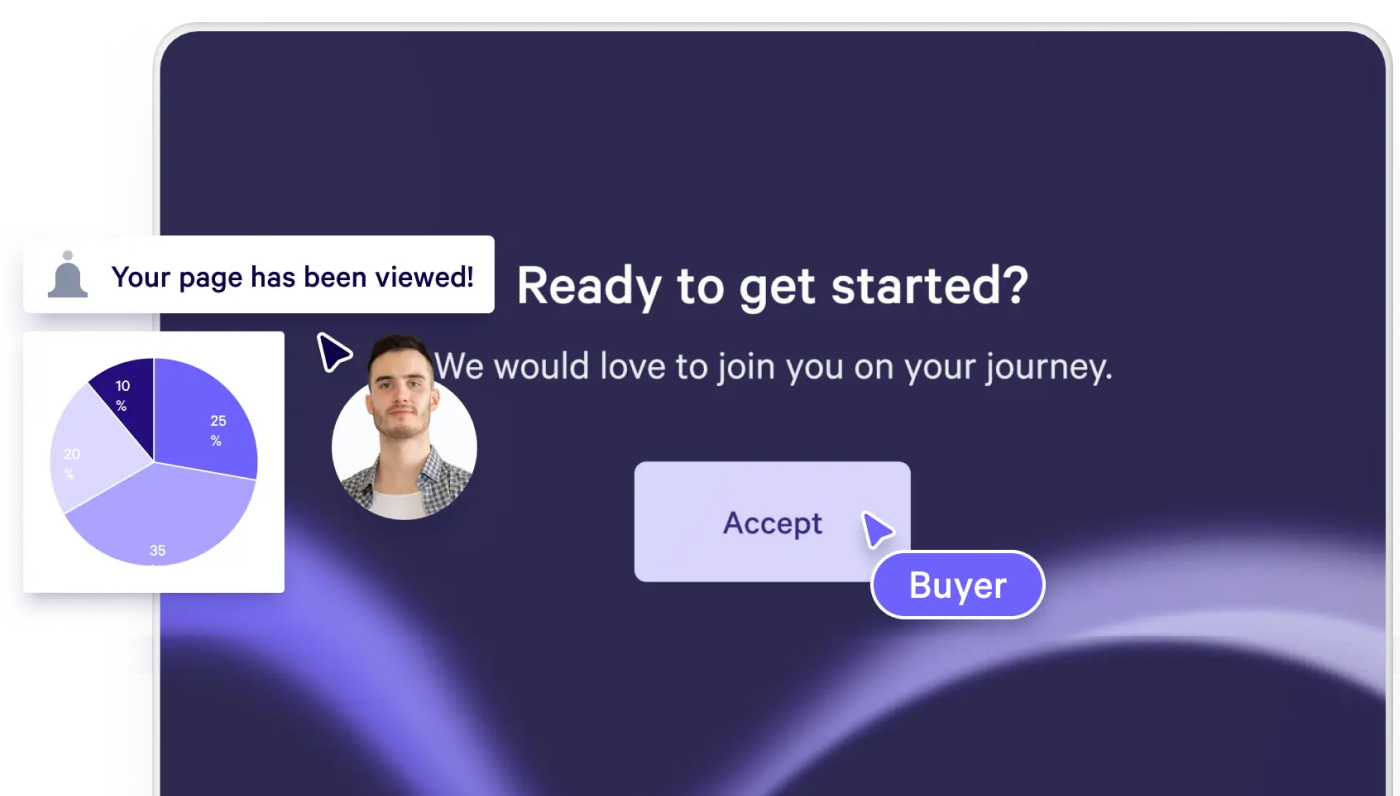
It’s tempting to imagine that there’s a universally accepted ‘best’ structure for any sales proposal.
However, like any other aspect of professional sales practice, there’s no quick fix for the perfect sales proposal structure.
Even when using sophisticated tools and templates (like Qwilr), your perfect proposal must match your target audience's and industry's needs. It’s also got to align with customer’s expectations of your brand and work in sync with your sales methodology and the holistic processes you use.
There are plenty of other variables to consider - but even with those we’ve just mentioned, it’s easy to see why proposals differ greatly, and an off-the-shelf template should only ever be considered as a starting point.
Executed correctly, all your sales collateral (including your sales proposal templates) will be specific to the buying experiences of your ideal customers, and finely tuned to minimize friction and maximize sales performance.
In this article, we’re going to break down the different steps of the proposal creation process. We’re also rounding up the most important sections to include in your proposal, regardless of your industry or product.
The six-step process of creating a sales proposal
1. Research
With enough research, you can ensure your proposal demonstrates to your potential client that you understand their company and their industry and can solve their problems.
As well as the initial research required to build your proposal template, you should ideally be researching each prospective client in order to tailor and personalize your proposal to each specific project. Our Buyer Experience Study in 2021 showed that two out of three buyers are influenced by the quality and customization of sales materials, and a quarter of them will only accept personalized materials.
The amount and nature of research required for each client may depend on your industry. For example, if you offer a service that’s required by a wide variety of clients (such as video production), then you’d immerse yourself in learning about that particular customer and their services.
Conversely, perhaps your service is more specific to one type of industry client (for example, if you’ve focused your copywriting or graphic design services on one particular niche). In that case, you may want to spend a greater proportion of your research time on analyzing your client’s market positioning and competitors.
This blend of customer and competitor research is essential to your proposal template creation. The more you can learn and incorporate into your template, the less you’ll need to adjust for individual proposals and projects.
2. Assess which elements you’ll need for your template
You’ll need a business proposal template that reflects whatever it is that you do. A videographer or graphic designer will want to include a portfolio section. A staffing agency proposal will usually include a section outlining the evaluation processes used to screen candidates.
In addition to these industry-specific sections, some elements are essential to almost any sales proposal (we’ll discuss those in more detail below). But, the more of these elements you can standardize, the easier it will be to put together proposals and the more time you'll have for customer-specific research and personalization.
3. Draft the outline
You’ve worked out which sections are necessary for your sales process and will give your prospective clients the information they need in order to be persuaded.
Now, you’ll need to start putting together an outline. It’s essential at this stage to think about storytelling. What impression do you want to create in your client’s mind? What will they need to know first?
People sometimes get put off by the fanciful, 'creative' associations of storytelling, but at its most basic, it’s just a form of information management - choosing the order in which you deliver your key messages.
It’s often a matter of common sense. No one starts a sales proposal with their pricing because that would be akin to asking for money without explaining why you should have it. Use the order in which you present your elements to build a clear line of reasoning that resonates with your prospective clients and leaves them struggling not to buy.
4. Fill in the outline and create your proposal content
Start filling in the sections of your proposal. Depending on your organizational structure and the level of technical detail required, you might need to delegate individual sections to other departments to write.
To streamline the creative process, make sure you’re using a robust platform that emphasizes easy collaboration between multiple users.
One important tip to remember is that you don’t need to squeeze every single detail of the product or service you provide into this proposal. Readability and clarity are your priorities; include all the highlights and enough detail, but don’t get too bogged down in specifications - you can include T & Cs as a clickable link towards the end of the proposal.
Having said that, for companies like IT service providers, technical details are an unavoidable aspect of their services. For these companies, cutting through the jargon is vital. Being able to communicate the offer without baffling and unnecessary detail is usually a major priority they try to address in every proposal.
5. Enhance your proposal design with visual elements
Once you’ve created the written content that is going to keep the buyer reading and (hopefully) close the deal, your next step is to create an attractive, professional design. Visuals are a hugely important aspect of any sales materials you create.
Your proposal must create a good first impression, and this is where using pro proposal creation software comes in handy. Along with hundreds of sleek, modern templates to choose from, a tool like Qwilr allows you to incorporate your own branding materials (such as logos, fonts, and color schemes) and gives an impeccable mobile-friendly performance.
Using Qwilr also allows you to include interactive elements such as e-signatures, interactive pricing tables, or video content, without the need for coding or third-party solutions. These interactive elements can also improve the accessibility of your proposal.
6. Proofread and edit
Take your time with this final stage - it’s tempting to try and shorten the sales cycle here by rushing the ‘finished’ proposal over to the client. However, you don’t want to waste all your hard work up to this point by creating a bad impression on the client with missing content, design flaws, mismatched fonts, or typographical errors. No one wants to hire someone who can’t pay attention to details.
The key elements of any good sales proposal
As we’ve pointed out already, an essential piece of the proposal process is personalizing your offer to your client, and one-size-fits-all templates should only ever be considered a starting point.
However, there are common elements shared by almost every sales process (for a deeper dive, we created this webinar for you to check out, too). Whatever your industry or sales methodology, your best proposals will likely include some combination of the following elements. Here's our proposal template checklist.
Proposal front cover
A visually attractive front cover page can create an immediate good impression while also conveying useful basic information. This includes the project name, any project reference numbers, the name and contact details of the client, the name and contact details of your own company, and the date you’ve submitted the proposal.
If you aren’t using proposal creation software, then keep your design clean, simple, and professional.
Executive summary
This section is similar to an elevator pitch. It’s intended to provide a short, hard sell that condenses the main benefits of your solution to the client’s problem. This section should still work as a summary for C-suite executives if they don’t have the time to review your proposal in detail. It’s not necessary to include every feature that you’re offering the client.
The executive summary is best understood as a set of microsections, each with a separate purpose in persuading the reader to read further, take action and close the deal.
- Introduction. Hook the reader in with a bold statement. Address the reader, their issues, and desired results directly.
- The pain points. Demonstrate your understanding of the client’s problem and its context. Include details here that reference your research or related experience of similar problems.
- The solution. It’s important to keep this microsection as tight and focused as possible. Respond only to the aspects of their problem that you mentioned already. There’s time to explore this further later in the proposal.
- Why us? Succinctly provide convincing proof that this solution is the best answer to the client’s problem and that your services are the most effective implementation for that solution. It’s not the place for lengthy testimonials or social proof. However, if you’ve got something sufficiently convincing (such as a prestigious award or thought-leader endorsement), then you might mention it here.
- Call to action. Even though you want them to read the rest of the summary, you can still let them know here how to respond to your proposal once they’re done with it. As we said, this might be the full extent of the CEO’s involvement with your proposal, so indicate next steps right here.
Your approach
Assuming you’ve provided enough analysis of the client’s problem in the executive summary, then this section is where you’ll explain how you'll fix it. Some proposals benefit from a more detailed pain-point assessment or technical report here, depending on the nature and complexity of the issues.
It’s a good idea to make this section as specific and personalized to the client as possible. You may find the solution you’re often proposing is a fairly standard service you provide for most of your clients. If this is the case, you can still use language that references the client’s specific situation, environment and resources to increase the sense of a bespoke service.
Deliverables
Provide an itemized list of exactly what your solution entails. If you’ve sufficiently demonstrated the benefits of your service, then this section is where you can explore the individual features involved in more depth.
From your extensive research (or the request for proposal, known as an RFP), you should have a good awareness of your client’s understanding of your services. However, it’s important to bear in mind that your proposal may be read by a variety of different decision-makers, with varying degrees of background knowledge of your field.
Try to accommodate this by including detailed definitions and descriptions of each deliverable for the benefit of the uninitiated. You can also provide scope, explaining exactly what is (or isn’t) included with each deliverable.
Project milestones
If you’ve explained exactly what your service includes, it’s good to go one step further and lay out exactly when and how those deliverables will arrive.
Using a timeline to graphically represent the process allows the client to better visualize your working relationship. It also creates a more aesthetically pleasing project proposal. Even if you can’t provide dates for each milestone, simply showing the phases of the process will help the client start thinking about timetabling the work.
Other information you can provide here (even if you don’t yet have the dates) includes:
- The approximate duration of each phase
- Any shared responsibilities or actions required from the client
- How each phase relates to overall progress.
Pricing or a cost breakdown
Providing an itemized breakdown will help clients understand the value of each component of your service and reassure them that they’re getting the best deal possible.
It’s also good to indicate where prices are provisional or where extra charges may occur.his kind of transparency builds trust and can reduce conflict later on in the relationship.
A tiered pricing strategy is a good way to accommodate variable budgets from client to client, as well as provide upsell and cross-sell opportunities. If your pricing strategy is sufficiently well-defined, you can use an interactive pricing tool to allow the client to adjust the package themselves to match their budget.
Another useful tool you can embed in your proposal is Qwilr’s interactive ROI calculator, which will help your client visualize the benefits of their investment in your services.
About us
This section is designed to give the client a better understanding of who you are, your experience dealing with issues like theirs, and your unique selling proposition (USP).
It’s also a great opportunity to start building the customer relationship by introducing the individual team members who’ll be handling the account. You can include pictures of specific individuals and include their bios to leverage the individual expertise and track records of your team.
Social proof
72% of consumers report increased trust in a business with positive reviews and testimonials.
A dynamic, interactive sales proposal template gives you a much greater degree of control over how you present your social proof. This can include anything from screenshots of social media reviews to comprehensive case studies that showcase your real-life results in a compelling and detailed narrative.
E-sign section
E-signature functionality is increasingly a sales proposal expectation in virtual selling situations. As well as saving time, money and physical resources, e-signatures allow your client to commit to the deal without leaving the proposal. This shortens the sales cycle and increases the effectiveness of your proposal as a persuasive sales tool.
Terms and conditions
Embedding a link to your T & C’s allows your proposal to effectively replace your contract as a legally binding document. It also makes it much easier to present the information in your proposal in a streamlined and readable format. The additional information that a client may need about specific aspects of your services can be included in the T & C’s, instead of cluttering the design.
Responsive proposal templates - a modern business necessity
In practice, the work required to produce a well-structured proposal from scratch that incorporates every feature we’ve mentioned in this article would be considerable.
Rather than tying up your graphic design team, your copywriters, and marketers for weeks on end, it’s far more cost-effective to use a high-quality proposal creation software tool like Qwilr.
With hundreds of templates to choose from, each tailored to the needs of different industries and popular sales methodologies, you can quickly create a master template that can be instantly adjusted and personalized to the individual client or project.
Our free 14-day trial will put you well on the way to pain-free, perfectly structured proposals.
About the author

Dan Lever|Brand Consultant and Copywriter
Dan Lever is an experienced brand consultant and copywriter. He brings over 7 years experience in marketing and sales development, across a range of industries including B2B SaaS, third sector and higher education.
Frequently asked questions
The most common proposal structure opens with an executive summary, followed by a detailed assessment of the client’s problem and the ideal solution being offered. The reader is then given good reasons or proof that the seller can provide the best result available, along with next steps or a call to action.
To influence the reader to take action, you should aim to make your sales proposals clear, concise, comprehensive and compelling.
A request for proposal (RFP) is a business document that a company can use to solicit bids from contractors offering services. It contains essential information about the scope and budget of the project that contractors can use to guide their proposal writing and meet the company’s expectations.




